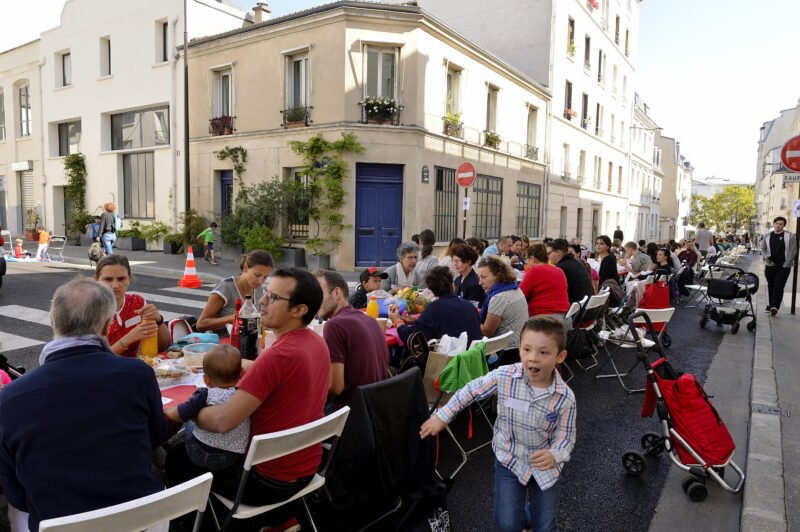Locating Urban History and ‘Piercing Time’
Piercing Time: Paris after Marville and Atget curates a visual conversation between the historical and the contemporary city of Paris.
Peter Sramek, Chair of Photography in OCAD University, Canada, led a group of researchers to study photographs taken of Paris in 1860s-70s (by Charles Marville) and in early 1900s (by Eugène Atget), locate the exact spots where these photographs were taken and capture their present urban form. As Marville was commissioned by Baron Hausmann for photographic documentation of old Paris neighbourhoods before their destruction to make way for the famous boulevard, the project brings together insightful visuals to revisit the history of the city. The group is now working on producing the printed copy of the documentation, as well as a mobile app for geo-tagged exhibition of the historical and contemporary photographs. They have created a campaign to support the project through the production phase. I was fortunate to get some quick responses from Peter regarding their work. Here is the conversation:
ajantriks: In my mind, the phrase ‘piercing time’ creates a sense of augmented urban reality, of looking across time but being spatially static. Do you use the phrase in a similar sense?
Peter: “I am using the phrase ‘piercing time’ to evoke that sense of moving through the years as one views the photographs, which span 150 years. It seems possible to experience that transition and that distance in viewing the images. I am also referencing Haussmann’s term ‘percement’ which was used to name the intrusive cutting through of the previous configurations with little regard for preservation of existing structures – be they architectural or social. In fact, my approach was to select a diagonal cross-section of the old city, mimicking Haussmann’s boulevards, and remake the photographs which Marville made along this broad line. My path covered areas which have seen a variety of changes at various stages of the past 150 years. In this way my piercing is temporal both in terms of the old and new images, but also the progress of urban development.”

How did you come across the pre-Hausmann Paris photographs of Charles Marville?
“I had previously worked with the early 20th century photographs of Eugène Atget in a similar project and one day when visiting the Musée Carnavalet to see original prints, the Curator of Photography, Françoise Reynaud, asked if I had seen the Marville’s. She showed me a few and made the suggestion that little had been done on this amazing collection. Within a few minutes I was hooked by these images.”
Can the project be an occasion to reflect on the relations between physicality of urban space and emotions of urban life?
“Most definitely, this work is about emotional conceptions of the urban space. As a foreigner, Paris holds a rich historical mystique which I project onto the photographs. There is a romance which has been built through visual art , culture and literature. Parisian tourism is built on that. At the same time, these images are not of the major sites, rather the vernacular spaces and I did speak with Parisians about how they think about their neighbourhoods, about the meaning of the old images and the history of where they live. FInally, much of this discussion centred on social change and attitudes towards cultural preservation. It was an important context to explore, because the Haussmann era saw such major social disruption as whole neighbourhoods were demolished. This has continued in the past few generations, although less dramatically, through gentrification of working class neighbourhoods. It provokes a sense of loss which surfaces in the interviews which reflect a strong personal attachment to the local urban environment.”

The photographs avoid showing human beings. I guess Marville’s reason for doing that was purely architectural, and you have followed Marville. Does this strategy under-represent the various social usage of these streets and spaces?
“The lack of visible human presence does emphasize the architecture at the expense of the social. Marville used long exposures so that moving people and vehicles are ghostly. A closer inspection does reveal quite a few people, mostly spectators of the photographic moment, who are standing still. They add to our fascination with details in the images, such as shop signage and other indications of the social environment. Similarly, I photographed with long exposures of between 2 seconds and 2 minutes, often very early in the morning. This was to reflect Marville’s approach, but also to reduce the overpowering presence of the automobile. This allows for a greater focus on the architectural changes and hopefully reflection on how these resulted from political and economic decisions, with their impact on the social context, rather than on a pictorial rendering of contemporary street activity.”
Finally, which books were you (and your colleagues) reading as part of this project?
“I read books on the history of Paris and its architectural development as well as general writing on the history of cities. A few gems, in my opinion, are: La Comédie Urbaine by Michaël Darin; Preserving the World’s Great Cities by Anthony Tung; Cities by John Reader; The Invention of Paris by Eric Hazan; Paris: The Secret History by Andrew Hussey; Les Plans de Paris: Histoire d’une capitale by Pierre Pinon, Bertrand Le Boudec and Dominique Carré; and Romantic Paris, Histories of a cultural landscape, 1800-1850 by Michael Marinanan.”
Key works specific to the photographs of Marville and Atget are: Marville: Paris by Marie de Thézy; Conventional Pictures: Marville in the Bois de Boulogne by Peter Barberie; and Eugène Atget: Unknown Paris by David Harris. Visit the project blog and the campaign page for more details.



